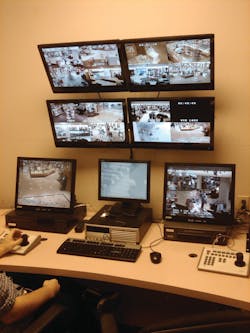Retail Vertical Market Focus: Shops Shun Shrink
Any football fan will tell you that the best defense is a good offense. If the offense is on top of things there is little need for extreme defensive measures.
That’s just the message for integrators who are trying to help retail customers avoid loss. This is especially true in high-value departments but also for preventing employee theft and providing perimeter or parking lot protection.
“Be proactive versus reactive,” said Todd Flowers, president of Surveillance Systems Integration (SSI), Roseville, Calif.
Too many times, retailers working with extremely hard-to-prevent losses are overwhelmed with responsibility of managing multiple locations, especially in this economy, commented Flowers. SSI specializes in working with a host of retailers, from large, national department store chains to small, local operations. In almost every case, the retailer has to do more with less.
“They must leverage technology to make up for the personnel deficit,” Flowers said. Using central management software to view multiple surveillance locations is one technique SSI uses.
Moving up from analog
Many, if not most, retail stores still are on basic analog video surveillance systems. The move, however, is to upgrade to something with better image resolution and more interoperability.
Kellie Vogel, national accounts manager/retail for SSI, noted that fine jewelry and high-end purse departments—areas with high shrink rates—are among the first places a store will install megapixel surveillance.
“The retail sector has been rather slow to migrate over to megapixel/IP,” she said. “When they see the ROI (return on investment) from solving a major case, then they are on board with the new technologies.
Retailers currently have a considerable investment in analog. “A remedy that protects their analog investment, while future-proofing for megapixel/IP conversions, combines UTP products and Cat 5e cable,” Vogel said. Cat5e cable is more cost-effective as well, compared to the ever-fluctuating cost of copper with standard coax cable. Moreover, as the megapixel/IP market continues to improve technology, reliability, and relevance in the retail sector, the costs are becoming much more attractive for retailers budgets.
“They are getting all of their wiring infrastructure in place and using UTP with video baluns for their analog products,” Vogel continued. “Once those analog products reach end-of-life, they are able to migrate IP cameras easily.”
Still, even the giant chains are reluctant to take the full plunge into an all-digital, high-resolution system. “Cost is a huge factor,” Vogel said.
With the number of POS (point of sale) systems that already have gone digital, there is precedent in the store. While POS stays separate, there is more flexibility. The software switch is less intrusive as hardware is phased out.
Working together with IT
A couple of years ago, most IT and security departments worked independently. Vogel said they are becoming more of a team. “Their departments can work together better since they can control bandwidth and run parallel networks,” she noted. With the advent of compression like H.264, IT is more willing to store files, creating thumbnail files, rather than streaming huge blocks of data.
While individuals still steal, today’s retailers face a different kind of shoplifter. “Booster” teams—five or six people working together on heists—are common.
Integrators find retailers typically want to protect the smaller take-off products: fine jewelry, handbags, perfumes. However, boosters will hit a men’s wear department and layer on several fine Italian suits before leaving.
Digital systems help here. Retailers can put cameras where losses occur and change those locations as shoplifters’ targets change. If the cabling infrastructure is in place, the retailer can pop in a camera into a targeted area and let security take over. “A digital camera is cheap compared to the loss of a few suits,” Vogel said.
A somewhat different tactic is taken with employee theft. There, retailers are better advised to deploy a covert product to capture employee activities, like workers taking money from the till or sticking goods into their lockers.
Parking lots also will benefit from digital. “The use of infrared technology has gotten better,” Vogel said. “People expect that level of security when they are in the parking lots after being in the establishment.”
Whether it is the property manager or the retailer, deploying megapixel technology is getting cheaper. “The expense to monitor the exterior perimeter is going down. They can replace two to five cameras to cover the same area,” Vogel said. These can be simple units rather than PTZs.
The big retail picture
Beyond technology, there are areas where retailers are moving forward, too.
Vendors and retailers participate and in a proactive system called Crimedex, which is like Facebook for criminals. This allows retailers to upload known shoplifters and thieves to a central database that can be shared with law enforcement and other retailers without violating privacy laws.
“Retail customers are looking to create a safe shopping environment for their customers while protecting themselves from ORC (organized retail crime) groups who steal millions of dollars of profit from retailers,” Flowers said.
Flowers said retailers get excited about high-resolution megapixel video that allows for greater detail and video quality while utilizing analytics for POS integration, facial recognition and activity detection.
SSI consistently integrates video with POS, access control and other analytics like facial recognition and object movement, Flowers said. Since this is a bit “out of the box” for many retailers, they provide training so the customer has a full understanding of how to maximize the technology.
Expect retail customers to want storage. In many cases, a retail chain will look beyond the short-term bust and collect data on so-called boosters. The immediate loss might be five Coach-brand bags. However, security will wait until the shoplifters hit a store in another county—where the courts are stricter—to make the bust there.
It is important to allow the retailer to archive that video efficiently to build a case.
Good defense can stave off the need to go to court at all. Retailers are looking at their public-view monitors (those big TVs at store entrances) as subtle warnings that the store is monitored. Bad guys know the store has a good face shot of everyone who entered.
However, thefts do not occur every hour. Retailers can capitalize on the value of their monitors by advertising when there is no activity. Rather than having the monitor near the perfume counters go blank, for example, they can stream a store promotion, for example.
Working together with security integrators
No offense, or defense, for that matter, will succeed if everyone does not play together. There has been some solid progress in this arena with retailers working together, especially with the National Retail Federation (see sidebar).However, one size definitely does not fit all.
“Each retail customer has unique needs,” Flowers agreed. While every customer desires the highest quality video, they must stay within budgetary restraints. “This can definitely limit the amount of technology that can be deployed,” Flowers continued.
Another unique challenge for each retailer is the aesthetics requirements presented by the décor of the stores’ environment. Aesthetics usually plays a significant role in the design.
Among the vendors Flowers is involved with in retail deployments are top-tier firms like Pelco, Dallmeier, Avigilon, 3VR, American Dynamics, Arecont, and IQinVision.
Down the road five to seven years, Vogel said she expects most retailers to be migrated to digital. “You will see more video everywhere,” she predicted. “The sexier the technology gets and the more affordable it becomes with faster ROI, the more megapixel and IP you will see.” Those high-resolution cameras will help chain retailers build stronger cases.
“People will see video as a necessity, not a luxury,” Vogel concluded.




